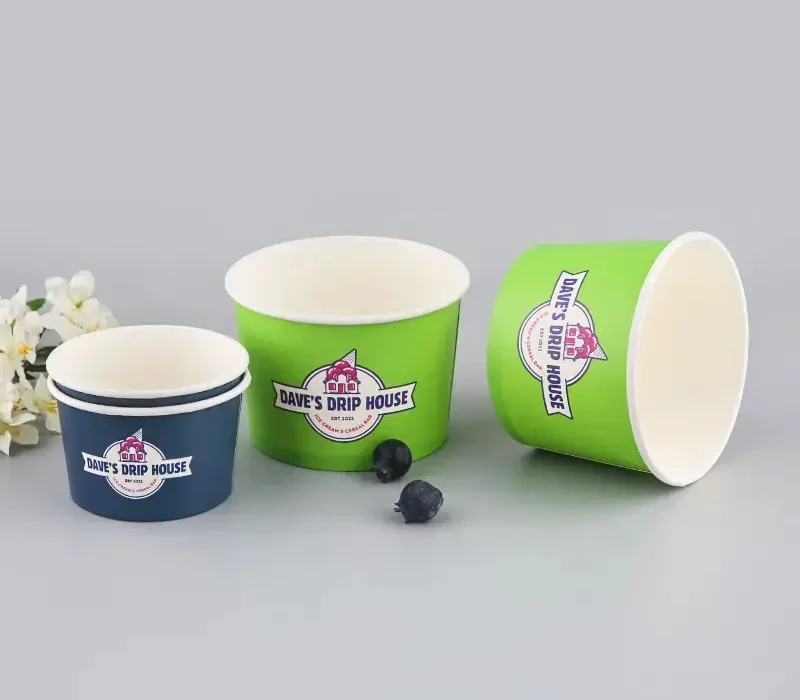Ice cream lovers often overlook what holds their favorite treat. The cup matters a lot. Using sustainable materials is not only kind to earth but adds value to your brand. Below are several great materials, showing their strengths and what your ice cream really needs.
Biodegradable Paper Cups with Wax or PLA Coating
Biodegradable paper cups are strong choices. They use paper that breaks down when composted. Coatings like wax or PLA (polylactic acid) stop melting and leaking. Paper with PLA coating comes from plants such as corn or sugarcane. Meanwhile wax can come from beeswax or plant wax. Both keep moisture out without heavy plastic.
These cups are light. They are easy to hold and insulate cold. They stay rigid even when ice cream melts a bit. Moreover, they are compostable in proper facilities. When disposed correctly, they break down in months. In contrast many plastics take centuries.
However, some points need care. The wax or PLA coating must be food-safe. Also composting services must accept those materials. If not, they may go to landfill and not decompose well. People should check local recycling rules. It matters a lot.
In design you can add logo or fun colors. For branding you might use custom printed ice cream cups to show identity and message. That step should not sacrifice food safety or material integrity. Print inks must be non-toxic and approved. Dozens of businesses use ink that washes off easily and is certified safe for food contact.
To sum up, biodegradable paper cups with wax or PLA are excellent. They balance function, safety, and environmental care. They reduce plastic waste. With proper composting they return to nature. Your ice cream deserves a container as kind to earth as it is cool.
Compostable Plant Fiber Bowls (Bagasse, Bamboo, Palm Leaf)
Bowls made from plant fibers like bagasse, bamboo, or palm leaf are smart choices. Bagasse is leftover sugarcane pulp. Bamboo grows fast without many chemicals. Palm leaf is fallen leaf material pressed into shape. These materials are natural, sturdy, and fully compostable.
They resist heat and cling well to cold. They can handle melting, dripping, and scooping easily. They are rigid and lightweight. After use they can be composted at home or in industrial facilities. They break down in weeks or a few months depending on conditions.
Their texture is nice. The feel is rustic or premium depending on finish. Some have smooth inside to prevent sticking. Others have slight grain for aesthetics. Either way they enhance the eating experience. Also, they need minimal coating; often natural fibers alone suffice.
Challenges include cost and availability. Sometimes plant fiber bowls cost more than plastic ones. Availability depends on suppliers. Supply chain matters. Also, they must be cleaned before composting. If stained heavily, composting facilities may reject them.
Still for brands wanting high environmental integrity, these bowls shine. Their life cycle from growth to compost returns value. Carbon footprint often lower than petroleum-based plastic. They avoid microplastics. For ice cream sellers, using plant fiber bowls shows care. It tells customers you think beyond today’s flavor. It cares for tomorrow too.
Edible Cups and Cones
Imagine eating your container too. Edible cups made of flavored wafer, cookie, or even chocolate is playful and zero-waste. Cones are classic example. Edible cups follow same idea of cones but often larger and flat bottomed for filling.
These are naturally compostable or eaten, leaving no waste. Ingredients matter: using whole grains or low sugar enhances nutrition. They usually break down if not eaten. Flavor possibilities abound: vanilla wafer, chocolate shell, biscuit texture. They add taste and delight.
Challenges: they melt or soften with time. They need to be stored dry. They may crumble. Also, they can be expensive to make or ship. Their shelf life may be shorter. Not as durable as paper or plant fiber. Also, they may not suit all flavors; very moist or runny ice creams may leak at seams.
Even so, edible containers are best when event or treat matters. They add novelty. They reduce packaging waste sharply. For diners, this becomes part of the fun. It draws attention and likely social media sharing. From my research, edible cups often get high praise for sustainability and experience.
Ice cream makers could combine edible cup with wrapper or liner to avoid mess. That still cuts waste sharply. They satisfy eco-concerned customers. Also, edible cups can be marketed as premium. They align with clean ingredient trends. So, edible solutions hold real promise as materials for what ice cream needs.
Recycled Plastic and Bioplastic Cups
Sometimes complete shift away from plastic isn’t yet possible. In that case recycled plastic and bioplastic are useful in transition. Recycled plastic comes from repurposed PET or HDPE. Bioplastics come from plants or microorganisms.
Recycled plastic reduces demand for new plastic. It saves energy and emissions. Cups made this way can be rigid, clear, or colored. They can handle freezing or melting without failure. Also, many such plastics are accepted in recycling systems. Check local rules though.
Bioplastics like PLA or PHA are alternatives. They can come from corn, sugarcane or algae. They may compost under industrial conditions. They break down faster than fossil-based plastics. Yet sometimes they need specific temperatures. Not all composting facilities accept them.
Consider drawbacks. Often cost is higher. Sometimes bioplastics behave differently: they may warp if too hot. Also, compostable bioplastics may not degrade in normal landfills. Recycled plastic sometimes still has microplastic issues. And clarity may be less perfect.
Still in many settings recycled plastic or bioplastic offer good durability. They support reuse if cleaned. For shops with take-away services, sturdy recycled plastic cups protect transport. For brands seeking greener image but needing performance, these are solid picks. Ensuring labelling informs customers helps. Consumers can sort waste correctly. Shops can help by guiding disposal.
Wooden, Sugarcane Lid and Spoon Combinations
Cups alone don’t solve waste. Lids and spoons matter too. Using wood, sugarcane, or other plant materials for lids and spoons adds completeness. Lids made from thin wood veneer or plant fiber; spoons from birch wood or sugarcane pulp are compostable.
Wooden lids fit snugly. They avoid leaks. They compost easily. Wood used for spoon is stiff and holds ice cream well. Sugarcane pulp spoons may have slight texture but work fine. All these parts break down in few months when composted.
There are details to watch. Sourcing must avoid deforestation. Wood must come from CSO or FSC certified forests. Sugarcane materials should use agricultural waste, not force new planting. Also, sterilization must use minimal chemicals.
These combos reduce plastic cutlery waste. They allow full compostable set. Customers feel good when everything is plant-based. Brands can market complete eco set. This gains trust and shows leadership.
In short, lids and spoons built with plant and wood materials complete the ice cream container story. They reduce single use plastic. They enhance compostability. They match chairs, packaging, cups in sustainability. Your ice cream needs not just cup but full feeding system that honors environment.
Conclusion
Choosing eco-friendly cup materials matters for ice cream. Biodegradable paper, plant fiber bowls, edible options, recycled plastic, bioplastics, and plant-based lids and spoons all offer paths. Each has trade-offs in cost, durability and composting. But the benefits grow over time. You help earth, delight customers, and build trust. Your ice cream deserves a home that’s gentle to nature.





